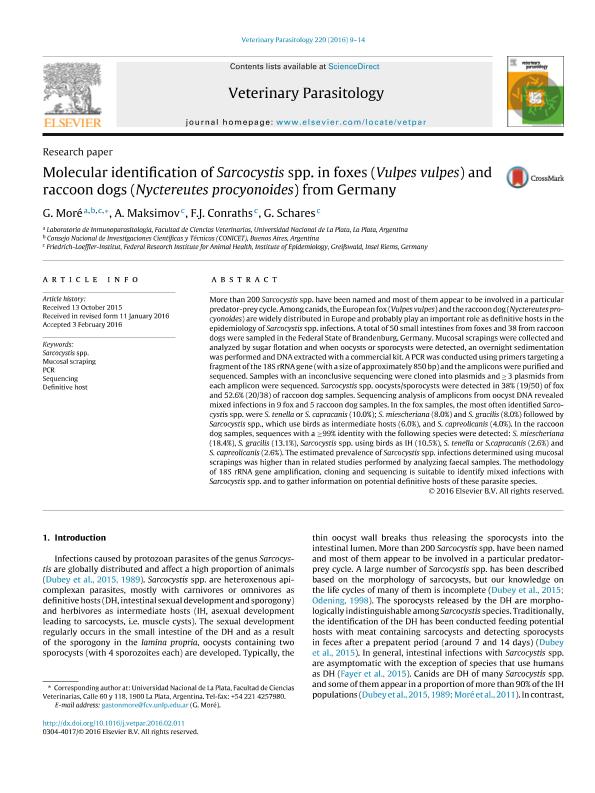Mostrar el registro sencillo del ítem
dc.contributor.author
Moré, Gastón Andrés

dc.contributor.author
Maksimov, A.
dc.contributor.author
Conraths, F. J.
dc.contributor.author
Schares, G.
dc.date.available
2018-08-03T16:47:29Z
dc.date.issued
2016-04
dc.identifier.citation
Moré, Gastón Andrés; Maksimov, A.; Conraths, F. J.; Schares, G.; Molecular identification of Sarcocystis spp. in foxes (Vulpes vulpes) and raccoon dogs (Nyctereutes procyonoides) from Germany; Elsevier Science; Veterinary Parasitology; 220; 4-2016; 9-14
dc.identifier.issn
0304-4017
dc.identifier.uri
http://hdl.handle.net/11336/54072
dc.description.abstract
More than 200 Sarcocystis spp. have been named and most of them appear to be involved in a particular predator-prey cycle. Among canids, the European fox (Vulpes vulpes) and the raccoon dog (Nyctereutes procyonoides) are widely distributed in Europe and probably play an important role as definitive hosts in the epidemiology of Sarcocystis spp. infections. A total of 50 small intestines from foxes and 38 from raccoon dogs were sampled in the Federal State of Brandenburg, Germany. Mucosal scrapings were collected and analyzed by sugar flotation and when oocysts or sporocysts were detected, an overnight sedimentation was performed and DNA extracted with a commercial kit. A PCR was conducted using primers targeting a fragment of the 18S rRNA gene (with a size of approximately 850 bp) and the amplicons were purified and sequenced. Samples with an inconclusive sequencing were cloned into plasmids and ≥ 3 plasmids from each amplicon were sequenced. Sarcocystis spp. oocysts/sporocysts were detected in 38% (19/50) of fox and 52.6% (20/38) of raccoon dog samples. Sequencing analysis of amplicons from oocyst DNA revealed mixed infections in 9 fox and 5 raccoon dog samples. In the fox samples, the most often identified Sarcocystis spp. were S. tenella or S. capracanis (10.0%); S. miescheriana (8.0%) and S. gracilis (8.0%) followed by Sarcocystis spp., which use birds as intermediate hosts (6.0%), and S. capreolicanis (4.0%). In the raccoon dog samples, sequences with a ≥99% identity with the following species were detected: S. miescheriana (18.4%), S. gracilis (13.1%), Sarcocystis spp. using birds as IH (10.5%), S. tenella or S.capracanis (2.6%) and S. capreolicanis (2.6%). The estimated prevalence of Sarcocystis spp. infections determined using mucosal scrapings was higher than in related studies performed by analyzing faecal samples. The methodology of 18S rRNA gene amplification, cloning and sequencing is suitable to identify mixed infections with Sarcocystis spp. and to gather information on potential definitive hosts of these parasite species.
dc.format
application/pdf
dc.language.iso
eng
dc.publisher
Elsevier Science

dc.rights
info:eu-repo/semantics/openAccess
dc.rights.uri
https://creativecommons.org/licenses/by-nc-sa/2.5/ar/
dc.subject
Definitive Host
dc.subject
Mucosal Scraping
dc.subject
Pcr
dc.subject
Sarcocystis Spp.
dc.subject
Sequencing
dc.subject.classification
Otras Ciencias Veterinarias

dc.subject.classification
Ciencias Veterinarias

dc.subject.classification
CIENCIAS AGRÍCOLAS

dc.title
Molecular identification of Sarcocystis spp. in foxes (Vulpes vulpes) and raccoon dogs (Nyctereutes procyonoides) from Germany
dc.type
info:eu-repo/semantics/article
dc.type
info:ar-repo/semantics/artículo
dc.type
info:eu-repo/semantics/publishedVersion
dc.date.updated
2018-08-03T14:16:24Z
dc.journal.volume
220
dc.journal.pagination
9-14
dc.journal.pais
Países Bajos

dc.journal.ciudad
Amsterdam
dc.description.fil
Fil: Moré, Gastón Andrés. Consejo Nacional de Investigaciones Científicas y Técnicas. Centro Científico Tecnológico Conicet - La Plata; Argentina. Universidad Nacional de La Plata. Facultad de Ciencias Veterinarias. Departamento de Epizootiología y Salud Pública. Laboratorio de Inmunoparasitología; Argentina. Friedrich-Loeffler-Institut. Federal Research Institute for Animal Health. Institute of Epidemiology; Alemania
dc.description.fil
Fil: Maksimov, A.. Friedrich-Loeffler-Institut. Federal Research Institute for Animal Health. Institute of Epidemiology; Alemania
dc.description.fil
Fil: Conraths, F. J.. Friedrich-Loeffler-Institut. Federal Research Institute for Animal Health. Institute of Epidemiology; Alemania
dc.description.fil
Fil: Schares, G.. Friedrich-Loeffler-Institut. Federal Research Institute for Animal Health. Institute of Epidemiology; Alemania
dc.journal.title
Veterinary Parasitology

dc.relation.alternativeid
info:eu-repo/semantics/altIdentifier/url/https://www.sciencedirect.com/science/article/pii/S0304401716300292
dc.relation.alternativeid
info:eu-repo/semantics/altIdentifier/doi/http://dx.doi.org/10.1016/j.vetpar.2016.02.011
Archivos asociados
